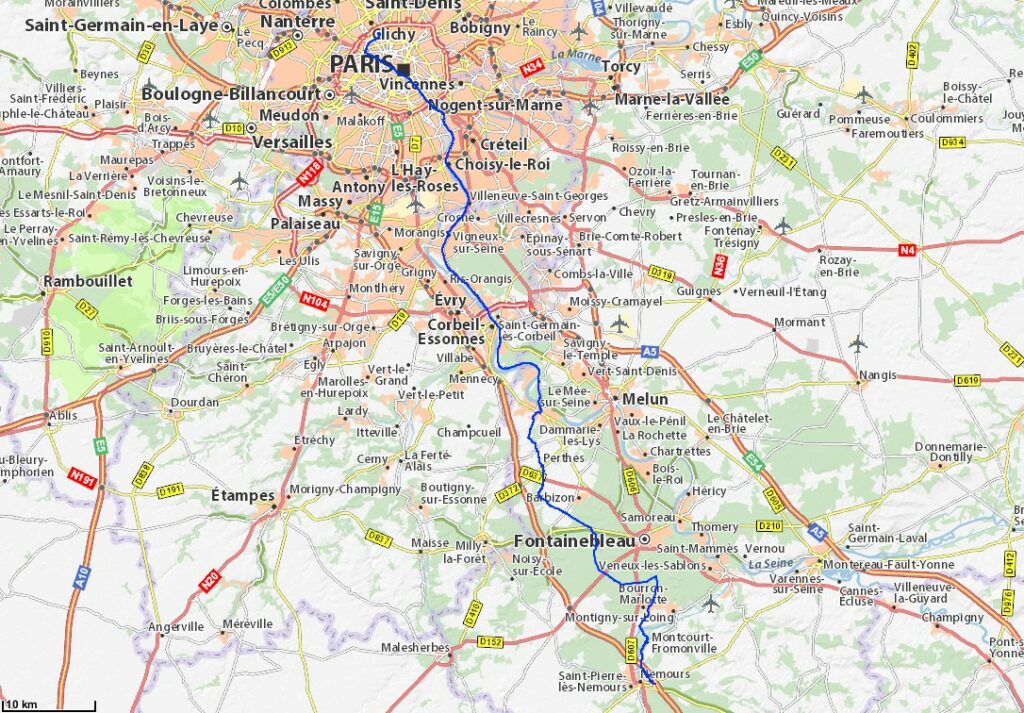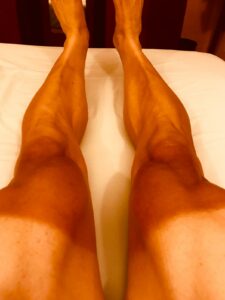They made it and are now in Paris. To complete a Grand Tour, whether professional or amateur, is a magnificent achievement and a milestone in your lives. I doff all my hats, caps and headscarves, send congratulations and have great respect for each and every one of you. Well done.


The last 4 stages were completed by half of the group, others already started their journey home in Dole. So today at noon, after an easy and flat 100 km, 11 riders arrived in Paris.
Interview with the Chief Cycling Officer
How are you doing after 20 Days cycling all over France, Chris?

Quite well and not even so much tired, but still we feel the completed distance. The legs are getting stronger and turn almost by themselves, but the “chassis” is already somewhat stressed.
The pros are certainly more worn out. While the daily go to the physical limits, we have driven no race and have needed about twice the time for the tour. So all in all we are doing quite well.
This is what cyclists’ legs look like. After 3 weeks, 20 stages, 3’300km and about 45km up in the mountains.
What does it take to ride a Grand Tour?
The Tour de France is the most famous and toughest bike race in the world. Riding a Tour is a privilege, respect it or it will bite you. As amateurs we don’t race, we race as ambitiously as our fitness allows. That the pros are doing this twice as fast as we are is almost unreal. Not only does this journey demand a lot from us physically, mental strength is also necessary, especially when you have to ride all day in the rain at only 5 degrees Celsius. No matter how strong you are, always respect the tour. But in the end, it’s these 3 weeks, this incredible journey and your experiences that make it a Tour de France.
What was the difference between this one and the Tour de Force we did in 2017?
The difference arose from the planning not to retrace the current tour, because here nowadays there are simply too many transfers from the destination to the next start. We wanted to proceed more on the principle of ski-in/ski-out, the hotel should be arrival and departure. That’s exactly why we chose the 1972 route, it offered this perfect loop.
We were thus not faced with the extra hassle of transfers and saved plenty of time. Also, we didn’t want to organize extensive stops and we wanted to go through the stages rather quickly, so that we would arrive at the finish in the afternoon and the participants would still have time for other activities. This worked out very well and was also well received. Especially after difficult and exhausting stages, there was more time to recover.
Please describe your best and your hardest day of the last 3 weeks.
In the Pyrenees we struggled and had to fight. We went from the sunny and warm Atlantic coast suddenly into cold and wet weather. Rain for two stages and only 5 – 7 degrees. Here we were all glad for the first rest day in Eaux Bonnes, especially since weather improvement was announced.
The best day was probably the stage on Mont Ventoux after the rest day in Carpentras. Despite the heat, all participants took this hurdle relatively relaxed and joyful and rolled at the end with a smile to the hotel, where we sat together for a very long time and the day took almost no end.
How did the group? All of them didn’t know each other before?
I would like to pay a big compliment to the participants. There were very different personalities among them, but regardless of the riding level or fitness level of the individual, there was always support and words of encouragement among them. They really cared about each other. Everyone wanted to do well, of course, and there were stronger and not-so-strong participants, but it wasn’t a race either; they wanted to do this tour together. The good ones also avoided pushing the pace too hard and took a more relaxed approach to the descents, so that no one was under any particular pressure. I liked that very much. A great bunch that made it to Paris, and what’s more, some of them were already over 60.
It’s also interesting to see the journey through the eyes of the other riders, or crew members. Everyone experiences it in a different way and there is a lot of respect among each other, so that everyone also experiences his best tour.
This time you havn’t had marker on the street and navigated with gps routing only.
GPS was fantastic, no one needs yellow arrows as route markers. A few times the GPS led us into a cornfield, once even down a flight of stairs. Well, the route was just planned on the computer. But it was always relatively easy to get back on the right track, even if a road was closed, we immediately found our way back to the route.
Technical issues ?
Incredible as it sounds, there were none. Not even one flat tire. This was probably also due to the fact that all participants came to us with perfectly prepared wheels. On 3’300 km no defects is already extraordinary. So we took our tools and spare parts for free.
In summary, what’s your conclusion?
The Tour is the best there is in cycling and expressly not reserved for professionals. Even an amateur can ride the Tour. With Velosence we now have a partner who can organize and carry out the Tour in our interest. Let Velosence show you the way, train and prepare for it, then you too can become a Tour rider. Ride the tour at your own pace, respect it and you will have a life experience.
So, what’s next, give us your outlook for 2020.
We can already say it worked wonderfully as we planned and executed it. So we will tackle it again for 2020, offer a new tour and take about twice as many riders, because this time we had to cancel some. Also we are thinking about applying the concept to a Giro d’Italia or a Tour of Spain, let us surprise you.
Chris Lewis and Richard Lebon wish many greetings to our German readers.
And what happens to me now?
I would now come back from Paris top fit, tanned, 5 kg lighter and a great experience richer and would have completed my third grand tour. Had it not been for that 2 cm curb on the first stage that doomed me. So now I’m the bird with the broken wing and that’s how I feel. Such a beautiful summer and I hang around immobilized arm. A carelessness and such a disaster, as my friend Andy said. And no, my disappointment hasn’t subsided yet.
The doc at the sports clinic says my collarbone will, as it looks now, knit itself together and I’ll be able to do everything again as before, but it just takes time. Only in the unlikely event that it doesn’t work out will I have to have an operation. A good sign are the x-rays and the fact that I hardly feel any pain and can work at my desk, but we will know more in mid-August.
So, that should be it now. Greetings to all cycling friends and families. Thanks for all the get well wishes and of course I will be back next year, no question. And of course I can already hear the mockery that something remained from the fall on my head. That’s the funny part, the serious side of it is that I wouldn’t be sitting here without a helmet and the matter would have turned out considerably more serious. Please never ride without a helmet, even short distances, always with!
So long, Roland.


